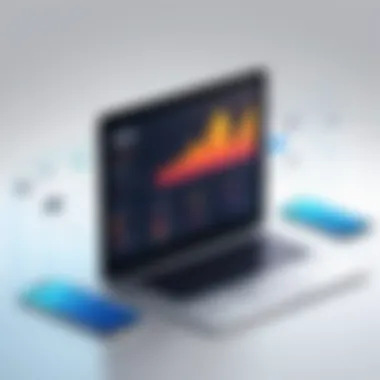Understanding Price Comparison Tools in IT


Intro
In today’s fast-paced technological landscape, price comparison services are becoming essential tools for IT professionals and tech enthusiasts. As purchasing decisions increasingly hinge on both budget and the right product features, understanding how to navigate these digital marketplaces has never been more critical. Whether you're a seasoned IT manager or a novice gearing up for your first tech acquisition, these platforms can greatly influence how you procure the necessary tools and software.
The objective here is to provide insights into the multifaceted realm of price comparison services specifically within the IT sector. We will dissect what these services entail, how they operate, and examine their impact on your purchasing strategies. Armed with this knowledge, one can make well-informed decisions, ensuring that procurements align not only with financial constraints but also with the technological needs of an organization.
Intro to Price Comparison Services
In an age where technology is advancing as quickly as a cheetah on the hunt, understanding price comparison services becomes essential for IT professionals navigating their procurement processes. With countless options flooding the market, distinguishing the good from the bad can be surprisingly taxing. Price comparison services bring clarity to this complex landscape, helping buyers make informed decisions, save time, and ultimately, cut costs.


These services take the guesswork out of purchasing tech products and services by enabling users to analyze various offerings side by side, showing not only prices but also features and specifications.
On the surface, it might seem like all that glitters is gold, but it's crucial to delve deeper into these platforms before diving headfirst into a purchase. These tools have evolved tremendously, adapting to the intricacies of the IT sector, where complexities abound.
Defining Price Comparison Services
Price comparison services can be likened to a buffet—gathering an array of options on a single table, allowing you to interact with your choices rather than blindly picking what’s presented to you. In the IT sphere, these services aggregate prices from different sellers for a wide range of products including software, hardware, and cloud services. Essentially, they serve as a bridge connecting buyers and sellers, allowing both sides to benefit from a transparent marketplace.
By integrating numerous data points, these platforms offer a comprehensive glance at relevant pricing and specifications. A basic understanding of these services could feel like the tip of an iceberg; beneath the surface lies a rich tapestry of features and functionalities that could change the way an organization approaches its procurement strategy.
Thus, the seamless experience provided by these tools is instrumental for any IT professional aiming to achieve optimal procurement outcomes.
The Evolution of Price Comparison in IT


Looking back, the evolution of price comparison services in the IT space resembles the metamorphosis of a caterpillar into a butterfly—a transformation marked by technological advancements and changing consumer behavior. In the early days of e-commerce, clients had to rely on a handful of sources and often paid hefty prices without much information.
However, as the digital landscape matured, so too did the methods of price comparison. With the rise of big data analytics and machine learning, platforms began to refine their methodologies, improving their ability to offer users meaningful insights. Now, consumers expect more than simple price lists; they seek rich context, including product reviews, expert opinions, and user-generated ratings, all in one place.
Moreover, the current shift towards Agile methodologies in project management has also influenced how these services present information. Users now crave flexibility and real-time data that enable them to make fast, informed choices. The evolution continues to unfold, and staying abreast of these changes is indispensable for IT professionals looking to maintain a competitive edge in their acquisitions.
The Mechanics of Price Comparison Services
Understanding the mechanics behind price comparison services is essential for those navigating the labyrinth of IT procurement. These services not only facilitate consumers in making informed decisions but also save time and often money. The core workings of these services hinge on data collection, algorithmic comparisons, and user-friendly interfaces. Their success lies in effectively marrying technology and user experience to deliver accurate and relevant price information swiftly.


How Price Comparison Works
Price comparison services aggregate pricing data from various retailers and platforms. Essentially, they act as informational hubs, bringing together disparate pieces of information under one digital roof. This aggregation process involves scraping data from websites, utilizing APIs, or partnering directly with vendors to maintain an up-to-date database.
Often, users input specific product requirements or search queries. The service searches through its records and presents a list, typically ranking results by price, availability, and other criteria such as ratings or shipping options. For instance, if a buyer is looking for a server with certain specifications, the comparison service will filter relevant results, making it easier to spot the best ticket in town.
Technology Behind Comparison Algorithms
The technology that powers these comparison algorithms is quite fascinating. At the heart of many price comparison engines are sophisticated algorithms designed to sift through large datasets. Most notably, these algorithms use machine learning techniques to enhance accuracy over time. By analyzing user interactions and feedback, they adjust how results are ranked or presented, continuously improving user experience.
A common method applied is web scraping, where bots gather data from a variety of sources. However, some platforms integrate APIs from retail partners, allowing real-time price updates. Such APIs can often lead to more reliable information but can be limited to specific vendors, further complicating the overall picture.
Example of a Simple Price Comparison Algorithm:
- User inputs search criteria.
- API fetches data from various retailers.
- Algorithm ranks results by price and relevance.
- User receives a structured presentation of options.



